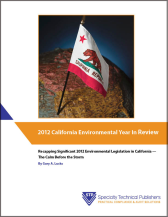Various changes were made to environmental legislation during 2012, both in the US and internationally. Here follows a summary of some of the headlines.
Audit, Compliance and Risk Blog
Tags: International, California Legislation, Environmental, EPA, Greenhouse Gas, ghg, Stormwater
By now, every reader should know that employers in the United States must verify would-be employees’ eligibility to work in the U.S. The critical form for doing so is Form I-9 (Employment Eligibility Verification), issued and administered by the U.S. Citizenship and Immigration Services (USCIS) unit of the federal Department of Homeland Security.
Tags: Business & Legal, Employer Best Practices, Employee Rights, EEOC
Within the U.S., the principal hazardous waste management law is the Resource Conservation and Recovery Act (RCRA) of 1976 (formally codified as Subtitle C of the Solid Waste Disposal Act (SWDA)). The US Environmental Protection Agency (EPA) sets national standards and directly administers RCRA in some states, while state environmental protection agencies administer RCRA and their state acts when authorized by EPA to do so. For domestic activities – including shipments of hazardous waste from a generator to a recycler or treatment, storage and disposal (TSD) facility, that’s enough to know to start compliance.
But if your U.S. organization imports or exports hazardous wastes, you need to know that RCRA incorporates requirements driven by US participation in international treaty - and membership-based organizations. Alternatively, if you’re a non-U.S. reader you may recognize the following elements in your own national requirements.
Exports Consistent with the OECD Agreement
The most relevant international agreement is from the Organization for Economic Cooperation and Development (OECD) – its 1992 “Decision C(92)39/FINAL Concerning the Control of Transfrontier Movements of Wastes Destined for Recovery Operations (OECD Decision)”, as amended. EPA’s RCRA regulations include specific provisions governing “Transboundary Movements of Hazardous Waste for Recovery Within the OECD.” (40 CFR §§ 262.80 – 262.89). As an exception to this coverage, separate rules provide similar requirements for exports to Canada and Mexico (under North American Free Trade Agreement (NAFTA), even though they're also OECD members) (40 CFR §§ 262.80 – 262.89). EPA revises these rules from time to time (most recently in 2010).
The following requirements apply to exports to Canada or Mexico (and to non-OECD countries covered by separate treaties with the U.S.):
(1) The “primary exporter” (typically the generator) provides EPA with a written notification of intent to export, at least 60 days prior to the first shipment. This notification must be in writing, signed by the primary exporter, and include the following information:
-
Name, mailing address, telephone number and EPA ID number of the primary exporter
-
The following information, by consignee, for each hazardous waste type:
- Description of the hazardous waste and the EPA hazardous waste number, U.S. DOT proper shipping name, hazard class and ID number for each hazardous waste
- The estimated frequency or rate at which such waste is to be exported and the period of time over which such waste is to be exported
- The estimated total quantity of the hazardous waste (consistent with Uniform Hazardous Waste Manifest)
- All points of entry to and departure from each foreign country through which the hazardous waste will pass
- Description of mode of transportation (air, highway, rail, water, etc.), and type(s) of container (drums, boxes, tanks, etc.)
- Description of how the hazardous waste will be treated, stored or disposed of in the receiving country (e.g., incineration, land disposal, recycling)
- Name and site address of the consignee and any alternate consignee
- Name of any transit countries through which the hazardous waste will be sent, description of the approximate time it will remain in such country, and the nature of its handling while there.
(2) The receiving country consents to accept the waste.
(3) A copy of an “EPA Acknowledgement of Consent” accompanies the shipment and, unless export takes place by rail, is attached to the manifest.
(4) The shipment conforms to the terms of the receiving country’s written consent.
(5) The shipment complies with RCRA manifest requirements (including the field for international shipments), modified to provide the address of the receiving consignee and alternate instead of facility, and to add the following to the certification of the shipment “and conforms to the terms of the attached EPA Acknowledgment of Consent.”
The primary exporter must notify EPA if the alternate consignee is used. If other problems arise, the primary exporter files an exception report with EPA; this follows requirements for domestic shipments, except that reports are filed with EPA Headquarters. Exporters must file an annual report with EPA summarizing the types, quantities, and destinations of all hazardous waste exported. Records must be retained for at least three years.
Exports to another OECD country instead must meet similar RCRA regulations designed to ensure consistency with OECD requirements. These include incorporation of OECD’s distinction between “Green Wastes” (wastes that present low risk for human health and the environment and, therefore, are not subject to any other controls than those normally applied in commercial transactions) and “Amber Wastes” (wastes presenting sufficient risk to justify their control). These RCRA regulations regulate as hazardous each waste that is a RCRA hazardous waste and/or an Amber waste not otherwise regulated as hazardous, and regulate Green Wastes as non-hazardous. These rules include notifications to EPA and consent by the receiving country similar to those described above, use of a “movement document” analogous to RCRA’s Uniform Hazardous Waste Manifest, and requirements for a contract for transportation and management of the wastes. Exported wastes are to be managed in compliance with the receiving country’s requirements for these activities.
Basel Convention Considerations
In addition to OECD’s provisions, 172 nations and the European Union have ratified the 1989 Basel Convention on the Control of Transboundary Movements of Hazardous Wastes and their Disposal (Basel Convention). OECD revised its Decision in 2001 to align with Basel Convention provisions. President George Bush signed the agreement on behalf of the U.S. in 1989, but the Senate has never ratified it. Absent ratification, the United States cannot participate in waste transfers with Basel Parties without a separate and equivalent bilateral or multilateral agreement. The OECD agreement and NAFTA treaties constitutes such multilateral agreements, and the U.S. also has bilateral agreements with Costa Rica, Malaysia and the Philippines.
Imports of Hazardous Waste
Importers of hazardous wastes must complete manifests for the wastes, substituting their name and facility identifications for the non-domestic generator’s. The importer must provide the transporter with an additional copy to submit to EPA in compliance with the transporter’s manifest requirements. If the import is from an OECD country, the importer must also ensure that the shipment meets OECD requirements.
Implementation Checklist
If your organization is involved in imports and/or exports involving U.S. territory, consider the following checklist. If it is involved in imports or exports involving other OECD countries, the same general issues apply.
Does my organization intend to export hazardous waste, acting as the “primary exporter"?
- If so, is the shipment being sent to:
- Canada or Mexico?
- Another OECD country?
- A non-OECD country?
- Has my organization secured formal consent from the receiving country?
- Has my organization notified EPA of its intent to export?
- Has my organization received EPA’s acknowledgement of the receiving country’s consent?
- Does each shipment comply with domestic U.S. manifest requirements, and applicable requirements of the receiving country?
- Does the organization retain all required records?
- Does my organization intend to import hazardous waste?
- If so, is the shipment being sent from:
- Canada or Mexico?
- Another OECD country?
- A non-OECD country?
- Does each shipment comply with domestic U.S. manifest requirements?
- Does the organization retain all required records?
Where can I go for more information?
-
EPA Hazardous Waste Import/Export webpage www.epa.gov/compliance/monitoring/programs/rcra/importexport.html
-
OECD webpage on transboundary movements of hazardous wastes www.oecd.org/env/waste/theoecdcontrolsystemforwasterecovery.htm
-
Basel Convention www.basel.int
Tags: International, Health & Safety, Environmental risks, Environmental, EPA, Hazcom
Until May 31, 2013, the U.S. accounting standard-setter, the Financial Accounting Standards Board (FASB), is seeking comments on its lengthy, 158-page proposed accounting standards update, Financial Instruments—Credit Losses (Subtopic 825-15), issued on December 20, 2012. The proposed guidance would change how companies determine when and how a credit loss should be recognized.
Tags: Business & Legal, SEC, Accounting & Tax, Accountants, GAAP, IFRS
Violence Against Women Act: Expanded Security Requirements On Campus
Posted by Jon Elliott on Tue, Mar 26, 2013
Earlier this month, President Obama signed the Violence Against Women Reauthorization Act of 2013, which renews and revises a wide variety of federal regulatory and grant programs intended to reduce gender-related violence against women. Although many of these protective measures are workplace-related, the amendments also expand protections for students at 99% of the nation’s colleges and universities (those that receive “Title IV” money from the U.S. Department of Education). These schools must comply with the Jeanne Clery Disclosure of Campus Security Policy and Campus Crime Statistics Act (Clery Act) by providing an Annual Security Report each October 1.
Tags: Employer Best Practices, Health & Safety, Workplace violence
Environmental Compliance: Roundup of California 2012 Legislation
Posted by Lorraine O'Donovan on Thu, Mar 21, 2013
In 2012 California made small amendments to its existing environmental laws while passing new laws to implement climate change and energy-related initiatives. Most of these changes became effective on January 1, 2013, and focused, among other things, on the following priorities:
This blog article discusses the formal post-implementation review (PIR) process for U.S. accounting standards used by companies, not-for-profit entities, and state and local governments.
Tags: Corporate Governance, Business & Legal, SEC, Accounting & Tax, Audit Standards, Accountants, US GAAP, GAAP
Corporate Governance: 2 Reasons To Review Indemnification Agreements
Posted by Jon Elliott on Fri, Mar 15, 2013
Litigation is an occupational hazard for corporate directors and officers. Fortunately, the hazard of directors' liability can be reduced substantially when the corporation indemnifies them from personal liability arising from their services. Indemnification is an undertaking by a corporation to reimburse legal costs and related expenses incurred to defend a claim, and may also include advances to cover defense costs as they are incurred. Indemnity arrangements may appear in the corporation’s charter or bylaws, and/or a separate agreement between the individual and the corporation. State laws govern indemnification, and apply through corporate bylaws and/or employment contracts with directors and officers.
Tags: Corporate Governance, Business & Legal, SEC, Employer Best Practices
Extreme weather is having an impact on the insurance industry with everything from hurricanes to blizzards resulting in increased activity in the sector. In order to remain profitable, insurers write policies that exclude certain types of damage, such as that often caused by water ingress. Most states regulate the sorts of exclusions insurers may specify in insurance policies, and state insurance bureaus receive filings from insurers seeking approval for such exclusions. The bureaus also carry out initiatives around consumer protection entailed by state legislation, and often release publications that educate consumers on their insurance options around mold damage and related insurance claims.
Executive compensation packages can become sources of tension between directors and shareholders in companies. In the U.S., state corporation laws authorize directors to fix their own compensation and to determine suitable compensation for the officers of the corporation, while federal income tax rules require shareholder validation before the company can deduct individual compensation exceeding $1 million ($500,000 for participants in the Troubled Asset Relief Program (TARP)). U.S. federal laws have expanded requirements for shareholder “say-on-pay” votes, but only require that the votes themselves be advisory, not binding. The 2009 federal stimulus bill requires participants to offer non-binding shareholder votes, and the 2010 Dodd-Frank Act requires all public companies to do the same. (See my recent blog on Securities and Exchange Commission (SEC) rulemaking).
Tags: Corporate Governance, Business & Legal, SEC, Employer Best Practices, International, Accounting & Tax










